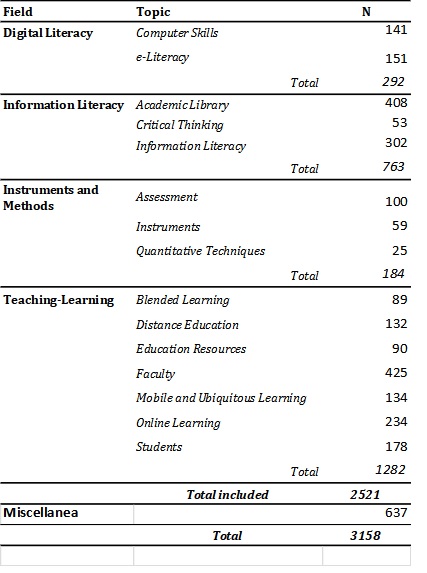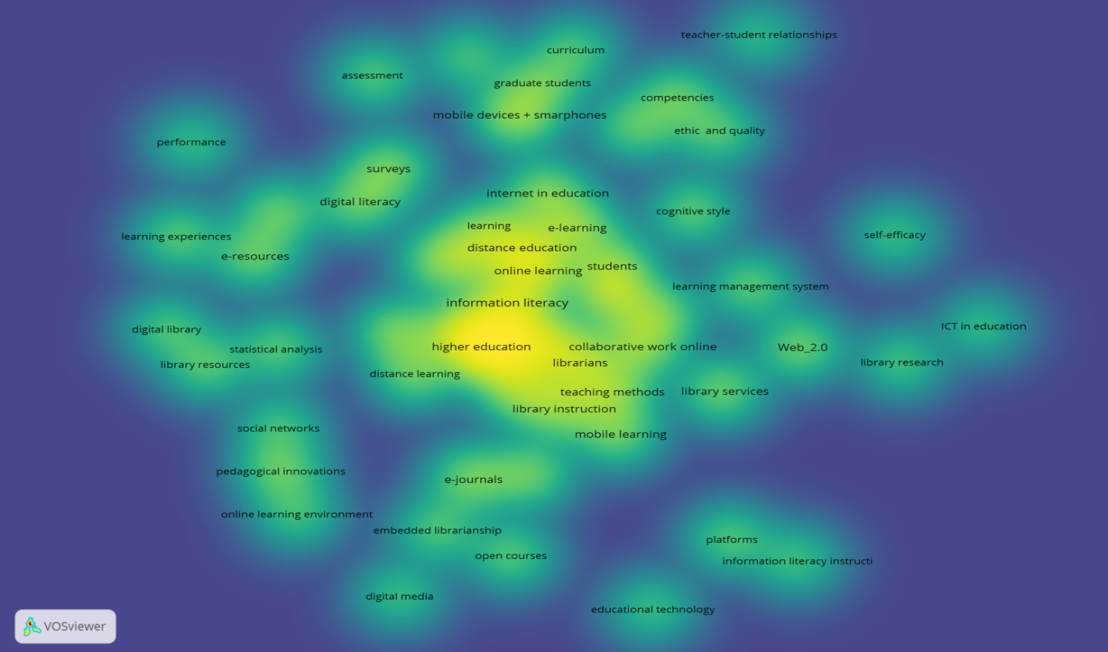Resumen
Se analiza la evolución temática de la investigación sobre Alfabetización en Información Móvil (MoIL) entre 2006 y 2019 en el campo de la Alfabetización en Información, el aprendizaje y las tecnologías móviles en un contexto internacional. Para ello, se recuperaron las referencias bibliográficas relevantes de cinco bases de datos (ERIC, LISA, LISTA, Scopus y WOS). Para sistematizar las palabras clave, se reduce la alta dimensionalidad mediante un proceso basado en términos. Se definen campos, temas, subtemas y términos principales. Los términos principales principales y sus relaciones se analizan aplicando la metodología de conteo fraccional utilizando el software VOSViewer. Se establecieron quince temas principales, que se agruparon en seis grupos para identificar las principales tendencias temáticas durante el período analizado: IL y e-learning, Dispositivos móviles y competencias, Ética, Biblioteca y recursos electrónicos, Tecnología educativa y Entorno tecnológico. Se detecta así la convergencia de la IL y el e-learning, el crecimiento de la e-alfabetización, la creciente relación entre los dispositivos móviles y las competencias de información, así como la de las bibliotecas y los recursos electrónicos. En conclusión, existe evidencia de una creciente interdisciplinariedad en las publicaciones científicas sobre Alfabetización Informacional Móvil, que interrelaciona los estudios de alfabetización informacional y digital con el e-learning y las tecnologías móviles.
Abstract
The thematic evolution of research on Mobile Information Literacy (MoIL) between 2006 and 2019 in the field of Information Literacy, learning and mobile technologies is analysed in an international context. For this purpose, the relevant bibliographic references from five databases (ERIC, LISA, LISTA, Scopus and WOS) were retrieved. To systematize the keywords, high dimensionality is reduced by means of a term-based process. Fields, topics, sub-topics and top terms are defined. The main top-terms and their relationships are analysed applying the fractional counting methodology using VOSViewer software. Fifteen major themes were set, which were grouped into six clusters to identify the main thematic trends during the period under review: IL & e-learning, Mobile devices & competencies, Ethics, Library & e-resources, Educational technology and Technological environment. The convergence of IL and e-learning, the growth of e-literacy, the increasing relationship between mobile devices and information competencies, as well as that of libraries and e-resources, are thus detected. In conclusion, there is evidence of a growing interdisciplinarity in the scientific publications on Mobile Information Literacy, which interrelates the studies of information and digital literacy with e-learning and mobile technologies.
Highlights
En lo referente a los contenidos posibles de MoIL, se han cubierto seis clusters temáticos, que tendrían que constituirse en los componentes básicos de su futuro marco conceptual: ALFIN y e-learning, dispositivos móviles y competencias, Ética, bibliotecas y recursos online, tecnología educativa y entornos tecnológicos. MoIL incluye competencias en cada una de estas tendencias, que en conjunto contribuyen a confeccionar un marco conceptual coherente.
Concerning possible MoIL contents, we have uncovered six thematic clusters, which should be basic components of its future conceptual framework: IL & e-learning, Mobile devices & competencies, Ethics, Library & e-resources, Educational technology, and Technological environment. These components represent the research trends within this sub-domain. MoIL involves competency in each of these six trends, which together may contribute to making-up a coherent conceptual framework.

Figure 1: Processing/categorization sequence

Table 1: Keywords by Field and Topic.

Figure 2: Density view showing the strengths of the most frequently used terms. The colours scheme ranges from blue–green to yellow, where yellow is related to the highest item density and blue denotes the lowest item density.
